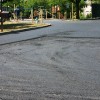Asphalt Surface Treatment
Video
alt="" Spreader BoxesAsphalt surface treatments refer to the reconditioning of the wearing (surface) course of older existing asphalt pavements. The term may also be applied to the final phases of new asphalt pavement construction. (Article 32.12.16 discusses Asphalt Paving).
Surface treatments provide enhanced waterproofing of the pavement, prevent the raveling (detachment and loss) of the fine aggregates (i.e. sand) from within the surface course of the pavement, smooth out existing surface imperfections, and provide improved skid resistance for vehicle traffic. Asphalt surface treatments are nominally less than an inch thick.
An inspection of the existing pavement condition should be conducted to verify that the selected surface treatment will be a sufficient remedy for the noted flaws. Prior to the installation of an asphalt surface treatment, the existing pavement surface must be clean and dry. Particularly, lose aggregates, twigs, dirt, etc, that will affect the binding of new asphalt to the existing pavement must be removed.
Surface treatments are installed by placing a layer of new asphalt binder on the existing pavement. The asphalt must be heated to the proper temperature, and is typically sprayed on with truck-mounted equipment. This is immediately followed by spreading equipment that places a covering of new aggregate materials on the asphalt binder. The aggregates are then compacted and locked into the new asphalt layer with steel and/or pneumatic tire rollers. This technique is also referred to as “chip sealing”. It is usually cheaper than other methods and can be accomplished with more routine equipment and training. A thin application of this process with the primary objective of waterproofing (without a substantial increase in thickness) is often referred to as a straight seal or “seal coat”.
Slurry seals provide an alternative application that can be installed in one pass of specialized resurfacing equipment. The ingredients of the slurry (aggregate, asphalt cement emulsion, additives and water) are carried separately in one vehicle, then mixed and discharged into a spreader box dragged behind the vehicle. The spreader box maintains a firm seal as it is dragged across the existing pavement surface. Slurry seals may be a better application to fill cracks and voids, depending on the exact conditions of the existing pavement surface.
Micro-surfacing is an enhancement of the slurry seal approach, with careful selection of more stable materials that allow for varied and thicker slurry applications. Micro-surfacing can be used to correct significant asphalt paving deformations, such as rutting. The placement equipment adjusts the treatment thickness to account for varied surface depths and features.
Another alternative is the placement of a fresh hot-mixed asphalt concrete layer on top of the surface (or wearing) course, definitively increasing the overall pavement thickness of the surface course, improving its strength and moisture control.
These asphalt surface treatments are intended to extend the serviceability of existing pavements before full-depth or more expensive repairs may be required.Separate from a surface treatment effort, individual pavement cracks can also be addressed through a variety of asphalt-based filler and sealants.

Buildipedia Staff
The Buildipedia research and writing staff consists of dozens of experienced professionals from many sectors of the industry, including architects, designers, contractors, and engineers.
Website: buildipedia.com/





